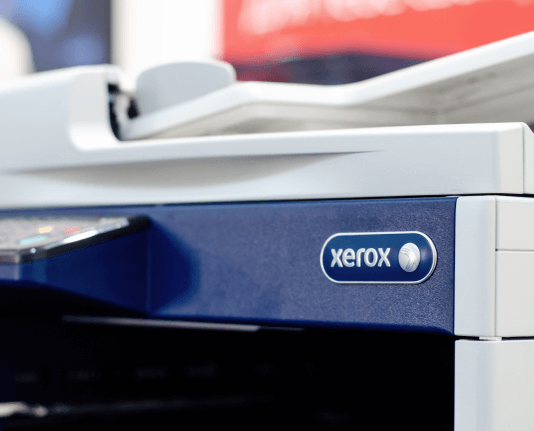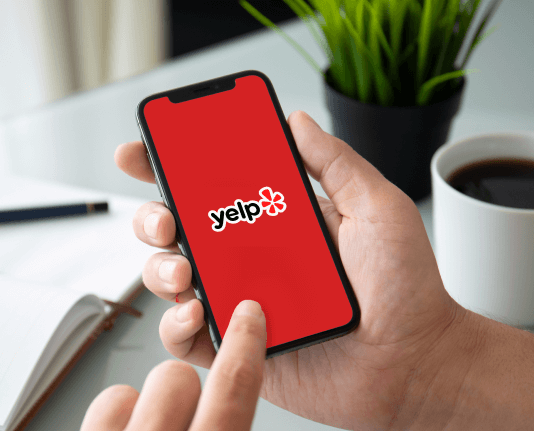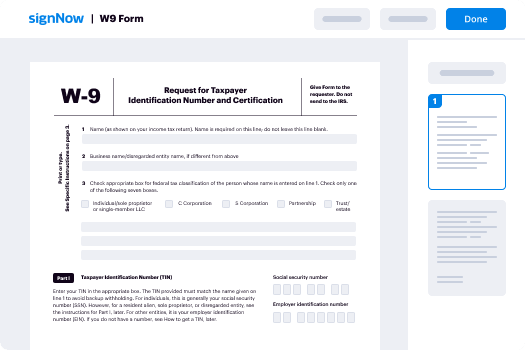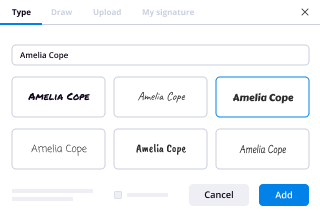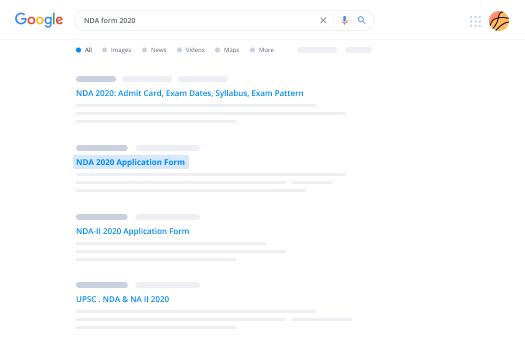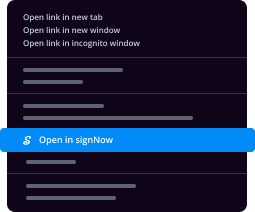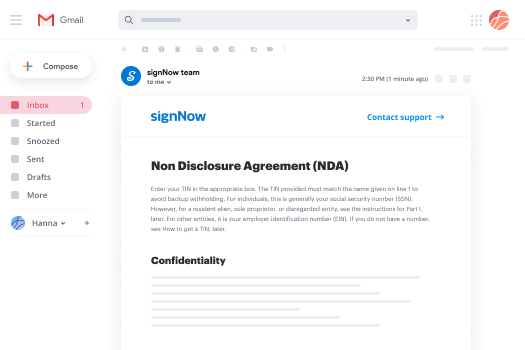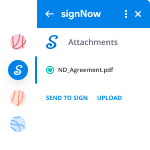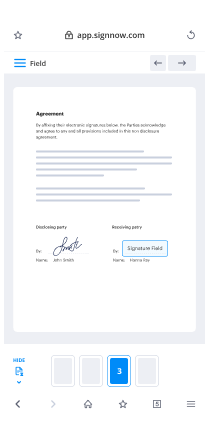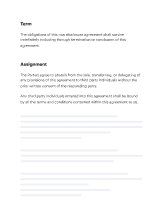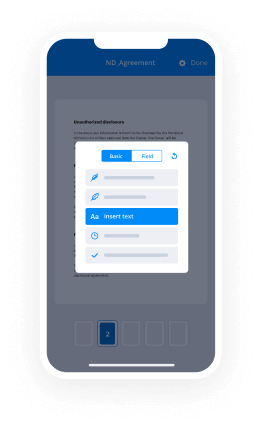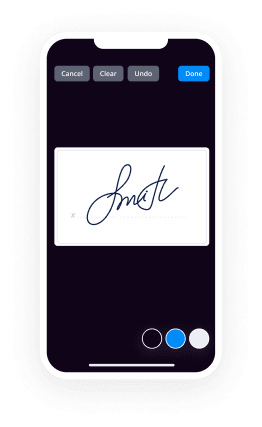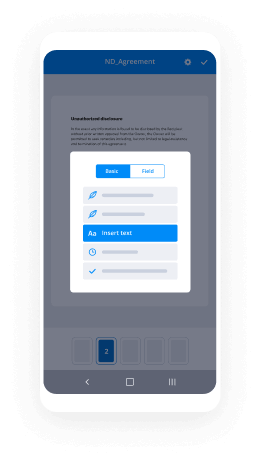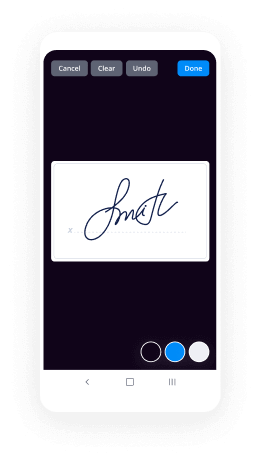How To Install Sign in 1Password
Contact Sales
Make the most out of your eSignature workflows with airSlate SignNow
Extensive suite of eSignature tools
Robust integration and API capabilities
Advanced security and compliance
Various collaboration tools
Enjoyable and stress-free signing experience
Extensive support
Keep your eSignature workflows on track
Our user reviews speak for themselves






Advantages of Utilizing 1password with airSlate SignNow
1password is an effective tool that boosts security and productivity when employing airSlate SignNow for electronic signatures. This guide will lead you through the key steps to utilize airSlate SignNow, ensuring your documents are signed safely and smoothly, enabling your business to prosper in a digital landscape.
Getting Started with airSlate SignNow and 1password
- Launch your web browser and go to the airSlate SignNow website.
- Sign up for a complimentary trial account or access your current account.
- Choose the document you want to sign or send for signatures and upload it.
- If you intend to use this document in the future, save it as a template.
- Open the uploaded document and modify it by incorporating fillable fields or necessary information.
- Sign the document, and add signature fields for any recipients who need to sign.
- Click 'Continue' to set up and send the eSignature invitation.
Utilizing airSlate SignNow unlocks many advantages, including a comprehensive feature set that maximizes your return on investment. Its intuitive interface is created to accommodate small and medium-sized enterprises, making it an excellent choice for expanding operations without the added complexity.
With clear pricing and no concealed charges, airSlate SignNow provides outstanding value along with 24/7 customer support for all subscription plans. Begin simplifying your document signing process today with airSlate SignNow and witness the advantages yourself!
How it works
Rate your experience
-
Best ROI. Our customers achieve an average 7x ROI within the first six months.
-
Scales with your use cases. From SMBs to mid-market, airSlate SignNow delivers results for businesses of all sizes.
-
Intuitive UI and API. Sign and send documents from your apps in minutes.
A smarter way to work: —how to industry sign banking integrate
FAQs
-
What is 1password and how does it work with airSlate SignNow?
1password is a password manager that securely stores and manages your passwords and sensitive information. When integrated with airSlate SignNow, it allows users to access their eSigning documents securely, ensuring that all digital signatures are protected. This enhances your document signing experience while maintaining high security standards.
-
How does the integration of 1password enhance the security of airSlate SignNow?
Integrating 1password with airSlate SignNow enhances security by providing a secure vault for storing passwords and sensitive information needed for document signing. This means that users can manage their login credentials safely and ensure that only authorized personnel can access sensitive documents. The combination of these tools helps protect your business from unauthorized access.
-
What are the pricing plans for using airSlate SignNow with 1password?
AirSlate SignNow offers a variety of pricing plans that can accommodate businesses of all sizes. While 1password has its own pricing tiers, the integration often leads to improved efficiency and cost savings, particularly in document management. You can explore these pricing options on our website to find the best fit for your needs.
-
Can I use 1password on mobile devices with airSlate SignNow?
Yes, 1password is available on mobile devices, and it works seamlessly with airSlate SignNow. This means you can sign documents on the go while ensuring that your passwords and sensitive information are readily accessible and secure. Both applications are designed to provide a user-friendly experience on mobile platforms.
-
What are the key features of airSlate SignNow that are enhanced by 1password?
AirSlate SignNow offers features such as document templates, advanced workflow automation, and secure storage for signed documents. When combined with 1password, users benefit from added security for their login credentials and sensitive information, making the entire document signing process more secure and efficient.
-
Is there a trial version available for airSlate SignNow with 1password integration?
Yes, airSlate SignNow offers a free trial that allows users to explore its features, including the integration with 1password. This trial version enables potential customers to understand how both tools work together to enhance document signing and security. Sign up today to experience the benefits firsthand.
-
How can I set up 1password with airSlate SignNow?
Setting up 1password with airSlate SignNow is straightforward. First, ensure both applications are installed, then follow the integration instructions available on our website. This will allow you to securely manage your passwords while efficiently handling your document signing needs.
-
How can I sign up for WeChat on my Mac without owning a phone?
For all you Mac users with Mac OS X 10.7 (Lion) or later, simply download WeChat for Mac in the App Store and scan the QR code to log in. Along with being able to chat with WeChat friends and groups on your desktop, the Mac App makes it easy to transfer files from your mobile device to your desktop and vice versa with the “File Transfer” capability. Just drag and drop your photos, media and other files into the “File Transfer” folder. Or upload desktop files directly within a chat to send to friends. As long as you’re logged into WeChat for Mac, alerts will pop up on your computer’s menu bar without notifications on your phone. WeChat for Mac also supports Sight videos, allows users to view chat histories forwarded by friends and search contacts as well as groups. So whether you’re chatting on your desktop, iPad, or smartphone device, WeChat constantly aims to innovate and deliver you the best cross-platform social communications experience possible.
-
How do I use a one-time password for my Google account?
[Disclaimer: I work for 1Password, a password manager that is also an authenticator app for storing one-time passwords.]Set up 2-Step Verification for your Google accountGo to the 2-Step Verification page. You might have to sign in to your Google Account.Select Get started.Follow the step-by-step setup process.Use an authenticator app like 1PasswordIf you set up 2-Step Verification using SMS text message or Voice call and also want to be able to generate codes using your mobile device, you can use an authenticator app like Google Authenticator or 1Password to receive codes even if you don’t have an Internet connection or mobile service.Learn how to use 1Password as an authenticator for sites with two-factor authentication.Sign in with 2-Step VerificationGo to the sign-in page and enter your username and password like you normally do.Then you’ll be asked for a second verification step, like a six-digit code or a prompt, which you'll receive from Google on your phone. If you want, when you enter your code, you can choose to trust your computer – this means you won't be asked for a second verification step again when you sign in from this computer. If you sign in from another computer, however, you’ll be asked for a second verification step.If you're trying to use a less secure app or device with your Google Account, you may be asked to sign in using an app password. You'll only have to do this once for each device and application.Sources: Turn on 2-Step Verification, Install Google Authenticator, How you sign in with 2-Step Verification
-
Is 1Password still the best way to store passwords (2016)?
The best is by far Password Safe.It was designed by Bruce Schneier, it’s open source and can be readily verified and audited. It doesn’t get any better than that.Oh. Yeah. Unless you need to run it on something other than Windows (and maybe Linux, that’s still beta).Then you run into trouble. There are a dozen or so “clones”, usually based on the open source - but they’re closed source and you don’t have any insight at all into what else they added, what they fucked up, or anything else you really care about if you care about security.I wound up chosing 1Password when I migrated back to Mac some years ago. It was sort of a mistake - I meant to click on pwSafe, one of the Password Safe clones, and got this instead.I’m not exactly completely thrilled, but at the time pwSafe didn’t have an iOS version, and 1Password did, so I rolled with it.Here’s what I don’t like: if fucking takes over your life.Every time any browser exhibits any sign of performing anything that could be construed as logging in or creating an account, it wants in on the action. It’s pretty aggressive about it, too. Doesn’t like to take “no” for an answer. And if you answer “no” on a site today, it’ll be back again asking once more tomorrow….Password Safe is a SAFE. It’s a secure container that you use to manage your data, and it doesn’t make any assumptions about when or where or how to apply that. That part is all on you.1Password and Last Pass are both really aggressive “no, let me handle that for you” programs. I don’t like that. At all.I’ve got a situation right now where a departing employ left me a Last Pass repository for all of the admin passwords he was using, and if I actually install Last Pass to access it, I blow up my existing 1Password installation.Which pretty much has me pushed to “just kill everything and install pwSafe until I can do my own port of Bruce’s code to OS X”.
-
Are developers of popular password management software (i.e. LastPass) forced by law enforcement to install backdoors in their e
I also work for AgileBits, the makers of 1Password.As Khad said, we don't have the capacity to intercept or decrypt your 1Password data. But your question goes beyond that. Could we be compelled to change our system to deliberately weaken it? Is it likely that we ever would be "asked" to?Until recently, I thought that providers of true end-to-end encryption would be immune to such "requests/orders/compulsion". It's only if you had the capacity to intercept data, passwords, etc that you could be compelled to do that interception (or allow others to intercept). However the story of Lavabit terrifies me. Of course we don't know what happened there (anyone who does know isn't allowed to say), but lavabit was designed to provide end-to-end encryption. (Though it did have access to the encrypted data, unlike 1Password.)So prior to lavabit, I considered the possibility of compulsion so remote that I never worried about it. I still think that it is a small chance, given how 1Password operates. But it is signNow enough to be worth some serious thought. So here are a few things to keep in mind:We have developers in four different countries. (CA, US, UK, NL). It would be difficult to gag all of us.Lavabit has set a precedent in how to respond. I like to think that we would take the legal and financial consequences of refusing to comply, but of course that is an easy thing to say now. Nobody really knows what kind of pressure governments could put on us or how we would personally respond.We are very open about our data design and security architecture. That should make it harder to deliberately weaken it without detection.Password managers are not, in general, communication tools. Perhaps that would make us of less interest.If the NSA/FBI/TLA is seriously after a particular 1Password user it would probably be easier (and less likely to be detected) to attack the targets operating system than to force us to change 1Password's design. That is, it is easier to go around 1Password instead of through it.Still I remain cautiously optimistic that we will never be confronted with such a request, largely because of increased public awareness. The risks of the TLAs getting caught doing something like that and there being a public outcry is very substantial. They lost the Crypto Wars back in the 90s. They are not off to a good start in Crypto Wars II.So could they compel us to sabotage our product and cheat our customers? Not with out a very high risk to that becoming public. Would they try it? I still don't think so.
-
What is the best password management software for cross-platform use; comparing KeePass, 1Password, and LastPass? Best would be:
I used to teach a cyber security course to the spec ops community and at different points provided the students with either LastPass or 1Password. I have very little familiarity with KeePass and others. A few thoughts based on my experience:Choose 1Password if:You are Mac onlyYou highly value a gorgeous app (emphasis on Mac only - their Windows version is as ugly as the Mac version is beautiful)Your prefer a relatively steep upfront cost (~$50 or so, I think, plus $10-$15 for iOS app) to an ongoing subscription. You don't mind the cost jumping to $70 if you use both Windows and Mac.You need basic strong password generation and storage, confidence in the security of your password file, the convenience of browser extensions, and a good mobile app that will sync, and nothing else.Choose LastPass if:Free is important (note you won't get mobile access without paying)You use Windows (only or alongside Macs)You don't mind a less-than-pretty, less-than-intuitive designYou prefer $12/year (if you need the mobile app - otherwise it's free) to the high upfront cost of 1PWYou need any of the following features (in addition to those I mentioned above for 1PW): - 2 factor authentication - the ability to share access to a password with someone else (e.g. a spouse or employee). Note I said 'access' - they won't see the actual password unless you want them to, but will still be able to use it for log in. - Master password entry via an-screen keyboard (so you don't have to worry about key-loggers - for example in a hotel business center or an internet cafe) - 1-time passwords (useful for defeating key-loggers and for account recovery) - super-easy access to your passwords when using a computer other than your own. This is also possible using 1PW, but requires a little more work.As for me, I'm torn. I'm Mac only and love the 1PW UI, but I'm currently trying to force myself to migrate to LastPass for the sake of some of those extra features (especially the sharing).Hope this helps!
-
How can I create a new WeChat account in my mobile?
Download the mobile app on the Apple App Store or on Google Play.If you click Sign-Up, it will ask you to enter your phone number.Once you enter your mobile phone number, you will receive a verification code on your phone. Enter the code and submit.You cannot create new WeChat account without using a phone number.You’ve just registered for a new WeChat account!Enter your preferred name that will show up on your contacts on WeChat.You can also link your email address with your WeChat account so you can sign in with your email address in the future. You can read up how to do it here
-
How do I get permission to install outdoor sign?
If you want to advertise about your business by installing some outdoor signs, then you need to first make application to the building official and then obtain the necessary permits, as per the California State regulatory code. You need to provide the required proof of licensing, to be verified through the CCSLB (California Contractors State Licensing Board) and obtain a license to install your outdoor sign.Wesco Signs is a known name in the signage industry. Along with manufacture, our specialized expertise also lies in outdoor sign installation. You can check out our works done for Orange County and Los Angeles areas at www.wescosigns.com. We obtain the necessary certifications and licenses for your business to install all types of outdoor signs, ranging from the monument signs to towering pole signs.
-
What is the average drop-off rate from app install to sign up?
Depending on how well designed your UX is, this will vary. However, you can expect Every Step Costs You 20% of Users. Yikes.However, there are some things you can do to improve your conversion rates. The most important thing is to be insanely metrics driven. To a fault. To the extent and depth you see in these Mobile App Analytics Insights.Aside from this, your product development makes a huge impact. Implementing a drop-in SDK like Branch Metrics to customize downloads will allow you to minimize the percentage of drop-offs. This tool, specifically, can pass data through app download for contextual user installs to support a higher conversion rate. It's free, and you can have it set up in just a couple of hours, so it's certainly worth it.Good luck.
Trusted esignature solution— what our customers are saying
Get legally-binding signatures now!
Related searches to How To Install Sign in 1Password
Frequently asked questions
How do i add an electronic signature to a word document?
What is a live electronic signature?
How to integrate esign with laserapp?
Get more for How To Install Sign in 1Password
Find out other How To Install Sign in 1Password
- Application form to get mentoring pdf
- Application for directed study pdf form
- Application for educational field placement form
- Application for structured minor registrar use only form
- Phs fcoi disclosure forms pdf d39youville college
- F 1 status extension application pdf form
- Domestic student insurance plan enrollment form pdf dyc
- Request for extension of time to complete the graduate program form
- Registration form pdf d39youville college
- 320 porter avenue dyc form
- Request for grade report pdf d39youville college form
- Tuition payment policies advance pdf d39youville college dyc form
- D39youville college tuition payment policies dyc form
- Personal schedule form pdf dyc
- Health records release form pdf d39youville college
- Thesis handbook form
- The place of evilthe place of negativity schelling earlham college form
- Ecu summer guitar workshop application east carolina university ecu form
- Office of student financial aid summer school application form
- Ecu college of education scholarship application ecu form

